Pallet Handling Training and Safety Guide
Everything you need to know about safely handling pallets and reducing injury risk.Pallets are found in almost every warehouse in almost every industry. Improper handling of pallets contributes to a large number of workplace injuries every year. PowerLift has developed a safe pallet handling system that will help reduce the occurrence of soft tissue injuries on the job.
Follow this pallet handling guide to successfully train your team to move, stack, lift, and load pallets.

Standing the Pallet
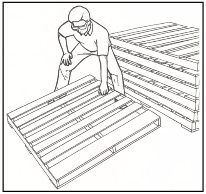 Lifting pallets from the floor – To POWERLIFT® a pallet from the floor, stand at the corner of the pallet, use wide stance and your legs to tip the pallet to a standing position. Note also that the free hand can be used as a strut on your leg to help you with the lift.
Lifting pallets from the floor – To POWERLIFT® a pallet from the floor, stand at the corner of the pallet, use wide stance and your legs to tip the pallet to a standing position. Note also that the free hand can be used as a strut on your leg to help you with the lift.
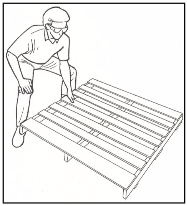
Tipping the pallets from the side – An alternate method of standing the pallet up is to lift it from the side. However, avoid back lifting by spreading your feet, bending your knees and using your free hand on your leg.
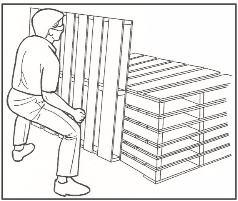
Lifting the pallet up to stack – Once the pallet is tipped, walk around to the opposite side, then again using wide stance POWERLIFT® technique, grasp the pallet with both hands, POWERLIFT® it up and place it on the stack.
Stacking the Pallet
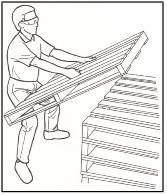 Tip on thighs to stack – An alternate method of lifting the pallet up to the stack is to tip it up on your thighs. Remember again to maintain a wide stance and tip the pallet with your legs. It is very easy to use your back with this lift so maintain a good POWERLIFT® posture. Remember also that tipping it at the thighs maybe beyond your personal capacity and should only be done if you are capable.
Tip on thighs to stack – An alternate method of lifting the pallet up to the stack is to tip it up on your thighs. Remember again to maintain a wide stance and tip the pallet with your legs. It is very easy to use your back with this lift so maintain a good POWERLIFT® posture. Remember also that tipping it at the thighs maybe beyond your personal capacity and should only be done if you are capable.
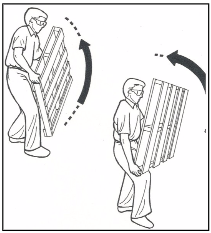 Roll up on thigh to stack – Another alternate way of lifting the pallet up to stack is to roll it up on your thigh. This method is generally much easier than it looks. Stand with a wide stance, knees bent with one leg slightly behind the other. Rest the pallet against your forward thigh then simply roll it up on your thigh and stack it. The one problem with the lift however, is that you can get slivers from the pallet in your leg. If you like this lift and must do It often, wear personal protective equipment over your thigh to protect your leg from slivers.
Roll up on thigh to stack – Another alternate way of lifting the pallet up to stack is to roll it up on your thigh. This method is generally much easier than it looks. Stand with a wide stance, knees bent with one leg slightly behind the other. Rest the pallet against your forward thigh then simply roll it up on your thigh and stack it. The one problem with the lift however, is that you can get slivers from the pallet in your leg. If you like this lift and must do It often, wear personal protective equipment over your thigh to protect your leg from slivers.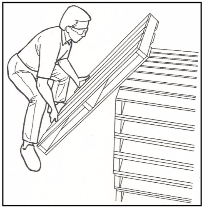 Slide to stack – An alternate method of stacking the pallet is to slide it on the floor to stack then lean the pallet on top of the stack. Now with wide stance POWERLIFT® position, center yourself to the pallet. Then lift and slide the pallet up to the top of the stack. The only limitation with this maneuver is the height of the stack.
Slide to stack – An alternate method of stacking the pallet is to slide it on the floor to stack then lean the pallet on top of the stack. Now with wide stance POWERLIFT® position, center yourself to the pallet. Then lift and slide the pallet up to the top of the stack. The only limitation with this maneuver is the height of the stack.
Pulling off the Stack
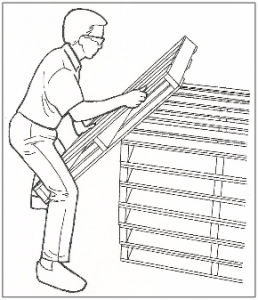
Pulling the pallet off the stack – To pull the pallet down off the stack, make sure you can pull the pallet to you with your legs. To lower it to the floor, simply guide the pallet down as it drops to the floor. Remember that as you guide it, stand at the corner with a wide stance and lower the pallet to the floor so that the corner passes between your knees. This keeps the load close and decreases the stress on your back.
Two Person Lift and Stack
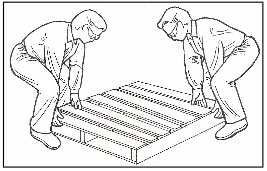 Two person pallet lifting for heavier oak pallets – When two people are lifting, always approach the corner of the pallet to create a 45º wide stance POWERLIFT®. You will find you won’t have to bend nearly as far lifting at the corner with wide stance as you would lifting from the side with your back. Once the pallet is up it can then easily be stacked by two persons.
Two person pallet lifting for heavier oak pallets – When two people are lifting, always approach the corner of the pallet to create a 45º wide stance POWERLIFT®. You will find you won’t have to bend nearly as far lifting at the corner with wide stance as you would lifting from the side with your back. Once the pallet is up it can then easily be stacked by two persons.
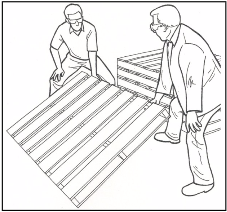 Two person tip the load technique – When two persons are lifting a heavy oak pallet you may wish to tip the load. To do this, step over the corner of the pallet on your respective side, then with your partner POWERLIFT® and tip the pallet to a standing position.
Two person tip the load technique – When two persons are lifting a heavy oak pallet you may wish to tip the load. To do this, step over the corner of the pallet on your respective side, then with your partner POWERLIFT® and tip the pallet to a standing position.
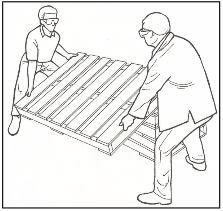 Two person stacking – Once the pallet has been tipped to a standing position step around to the side of the pallet and again use POWERLIFT® to lift it and place it on the stack.
Two person stacking – Once the pallet has been tipped to a standing position step around to the side of the pallet and again use POWERLIFT® to lift it and place it on the stack.
Two Person Unstacking
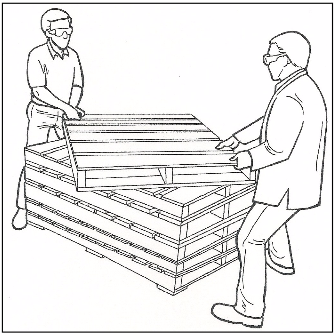 Lowering to the floor – If two persons are handling a heavy oak pallet and wish to take it down from the stack, use this method. First rotate the pallet on the stack so you are standing at the corner. Then POWERLIFT® it from the stack.
Lowering to the floor – If two persons are handling a heavy oak pallet and wish to take it down from the stack, use this method. First rotate the pallet on the stack so you are standing at the corner. Then POWERLIFT® it from the stack.
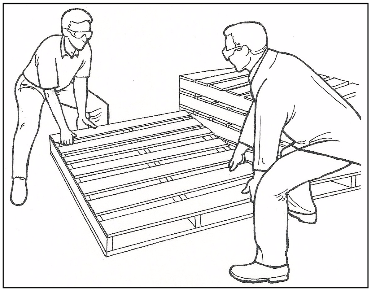 Lowering to the floor – Now that you have the pallet held at the corner, it becomes an easy task to lower it to the floor between your feet. This automatically puts you at a 45º angle to the load makes the job of lowering the pallet very easy.
Lowering to the floor – Now that you have the pallet held at the corner, it becomes an easy task to lower it to the floor between your feet. This automatically puts you at a 45º angle to the load makes the job of lowering the pallet very easy.
Increase safety. Reduce injury costs.
The Complete PowerLift® Training Program makes it easy to train your team with reality-based techniques and resources that are proven to reduce material handling and repetitive motion injuries.
Train the Trainer Sessions
- Live onsite training
- Online (Only recommended for recertification of trainers)
Staff Training Sessions
- Live: In support of your trainers
- Live: Our Master Trainers train your staff
- Online staff training module with hands-on activities. (Intended for temporary new-hire and remedial training.)
The PowerLift Library
- Over 1200 Safety Talks
- Training Resources: presentations videos etc.
- Marketing resources: posters, videos etc.
- Stretching guides
Other Services
- Assessments
- Implementation planning
- Custom content development: Custom Safety talks, videos etc.
